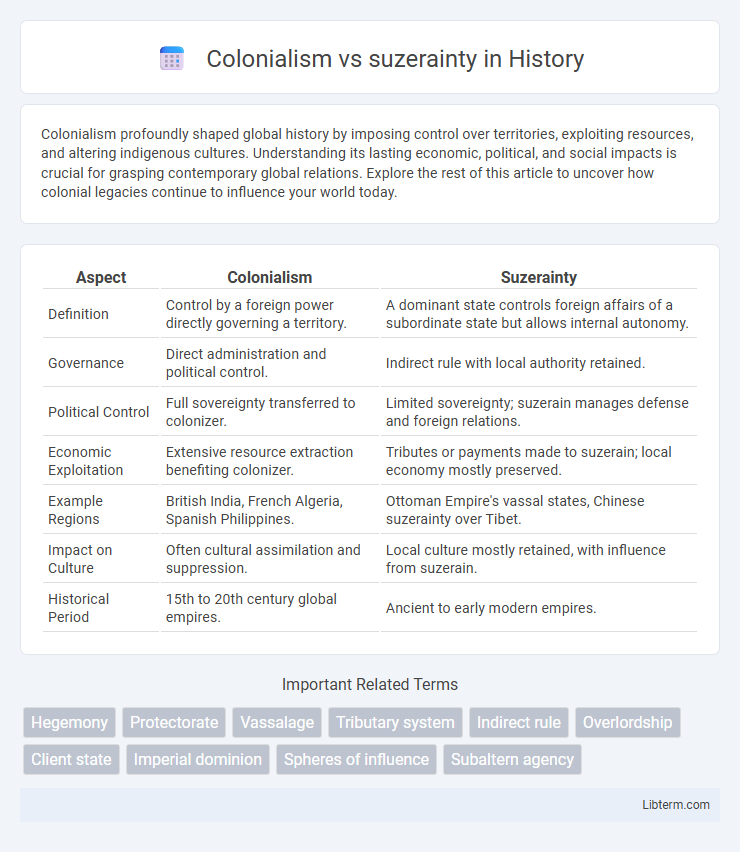Colonialism profoundly shaped global history by imposing control over territories, exploiting resources, and altering indigenous cultures. Understanding its lasting economic, political, and social impacts is crucial for grasping contemporary global relations. Explore the rest of this article to uncover how colonial legacies continue to influence your world today.
Table of Comparison
| Aspect | Colonialism | Suzerainty |
|---|---|---|
| Definition | Control by a foreign power directly governing a territory. | A dominant state controls foreign affairs of a subordinate state but allows internal autonomy. |
| Governance | Direct administration and political control. | Indirect rule with local authority retained. |
| Political Control | Full sovereignty transferred to colonizer. | Limited sovereignty; suzerain manages defense and foreign relations. |
| Economic Exploitation | Extensive resource extraction benefiting colonizer. | Tributes or payments made to suzerain; local economy mostly preserved. |
| Example Regions | British India, French Algeria, Spanish Philippines. | Ottoman Empire's vassal states, Chinese suzerainty over Tibet. |
| Impact on Culture | Often cultural assimilation and suppression. | Local culture mostly retained, with influence from suzerain. |
| Historical Period | 15th to 20th century global empires. | Ancient to early modern empires. |
Introduction to Colonialism and Suzerainty
Colonialism is a practice where a powerful country establishes control over a foreign territory, exploiting its resources and imposing its governance and cultural values. Suzerainty refers to a political arrangement in which a dominant state controls the foreign affairs of a tributary state while allowing internal autonomy. Both concepts highlight hierarchical power relations, but colonialism involves direct domination, whereas suzerainty implies indirect control and limited sovereignty.
Defining Colonialism: Key Features
Colonialism is characterized by the direct political control and economic exploitation of one territory by a foreign power, often involving settlement and resource extraction. It establishes a formal administrative structure where the colonizing country imposes its laws, culture, and governance on the colonized region. Unlike suzerainty, colonialism entails complete sovereignty over the territory rather than a limited control or influence.
Understanding Suzerainty: Core Concepts
Suzerainty refers to a political arrangement where a dominant state controls the foreign affairs of a vassal state while allowing internal autonomy, distinguishing it from direct colonial rule that imposes comprehensive control. This system emphasizes hierarchical sovereignty, where the suzerain exercises overlordship without full administrative integration. Understanding suzerainty involves recognizing the nuances of indirect control, versus colonialism's direct governance and territorial annexation.
Historical Origins and Development
Colonialism emerged during the Age of Exploration in the 15th century as European powers established direct control over foreign territories through settlement and exploitation. Suzerainty traces back to ancient and medieval political systems, where a dominant state exerted limited sovereignty over a vassal state, allowing internal autonomy while controlling foreign affairs. The development of colonialism involved territorial annexation and economic dominance, whereas suzerainty maintained hierarchical yet indirect control rooted in diplomatic and tributary relationships.
Political Structures: Direct vs. Indirect Control
Colonialism imposes direct political control through centralized governance and the establishment of foreign administrative institutions, often displacing local authorities and enforcing cultural assimilation. Suzerainty maintains indirect control by allowing local rulers to govern internally while recognizing the suzerain's supremacy in foreign affairs and military matters. This distinction results in varying degrees of sovereignty and administrative autonomy under each system.
Economic Impacts and Resource Exploitation
Colonialism imposed direct political and economic control, facilitating extensive resource extraction that heavily benefited colonial powers through monopolized access to raw materials and exploitation of local labor markets. Suzerainty allowed indirect control, often preserving indigenous structures and permitting more limited economic interference, but still demanded tribute or resources that constrained economic autonomy. The economic impacts of colonialism were typically more severe, causing long-term distortions in local economies by prioritizing export-oriented resource exploitation over sustainable development.
Cultural Influence and Social Change
Colonialism imposed direct political and economic control over territories, leading to profound cultural assimilation, language shifts, and the displacement of indigenous traditions. Suzerainty allowed local rulers to maintain internal autonomy, often resulting in limited cultural interference and a more gradual integration of outside influences. The nature of control directly shaped social change, with colonialism triggering rapid social restructuring, while suzerainty preserved indigenous social hierarchies and cultural identities.
Case Studies: Examples of Colonialism and Suzerainty
The British Raj in India exemplified colonialism, where direct control and administration over Indian territories allowed economic exploitation and cultural imposition by the British Crown. In contrast, the Ottoman Empire's suzerainty over the Khanate of Crimea involved indirect control, allowing local rulers internal autonomy while the Ottomans managed foreign affairs and defense. These case studies highlight distinct governance modes: colonialism's direct rule versus suzerainty's hierarchical vassal relationships maintaining nominal local authority.
Resistance, Adaptation, and Legacy
Colonialism imposed direct political control, sparking widespread resistance movements characterized by armed rebellions, passive non-compliance, and cultural defiance, while suzerainty often allowed for limited autonomy, leading to more negotiated forms of adaptation by local elites. Resistance under colonialism frequently resulted in lasting national liberation struggles, whereas adaptation under suzerainty involved balancing tribute obligations with internal governance. The legacy of colonialism includes deep socio-economic inequalities and cultural disruption, whereas suzerainty's impact is more nuanced, often preserving traditional power structures and enabling gradual modernization within subordinate states.
Conclusion: Lasting Effects on Modern States
Colonialism imposed direct political and economic control, often disrupting indigenous governance and exploiting resources, leaving many modern states with lasting economic inequality and institutional challenges. Suzerainty, characterized by nominal autonomy under the dominance of a suzerain power, allowed for limited local self-rule, thereby preserving some traditional structures but still influencing diplomatic and economic dependencies. Modern states emerging from these systems frequently grapple with issues of sovereignty, national identity, and development influenced by their colonial or suzerain legacies.
Colonialism Infographic

 libterm.com
libterm.com